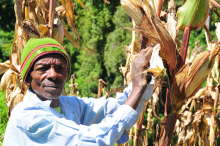
Agricultural systems in sub-Saharan Africa need to undergo urgent transformations as climate change will pose a significant threat to key food crops, according to new research published on 7 March in the journal Nature Climate Change. The study examines the likely effect of different climate change scenarios on nine staple food crops that constitute 50% of food production in sub-Saharan Africa. “This study tells where, and crucially when, interventions need to be made to stop climate change destroying vital food supplies in Africa,” says lead author Julian Ramirez-Villegas, who works with the International Center for Tropical Agriculture (CIAT). “We know what needs to be done, and for the first time, we now have deadlines for taking action,” he adds. If no adaptation actions are taken, for example switching crop types, improving irrigation systems, or in extreme cases moving away from farming, climate change could place the food security and the livelihoods of smallholder farmers at risk, the authors warn. Maize, beans and bananas will be most at risk. Up to 30% of areas growing maize and bananas, and up to 60% of the areas growing beans are projected to become unsuitable for production by the end of the century. The study suggests that almost 1.85 million hectares of current bean cropping systems in Uganda and Tanzania, where more than 40% of sub-Saharan Africa’s bean supply are grown, will be unable to do so by 2100. In other regions, transformations will need to take place earlier. Banana growing regions in West Africa and maize growing regions in Southern Africa, for example Namibia, Botswana or Zimbabwe, will need to adapt within the next ten years. Adaptation strategies need to differ across sub-Saharan Africa, respecting the different local conditions. The authors conclude that traditional varities of millet, sorghum, cassava, groundnut and yams can be viable alternatives since they have a higher tolerance to heat and drought. Other measures include improving irrigation options, making agro-climatic advisory services available to farmers and exploring other livelihood strategies, such as the introduction of livestock. But the authors also underline that there are promising examples of successful adaption efforts. In Uganda, for example, intercropping banana with coffee has been found to raise incomes of farmers by 50% and makes them more resilient to climate change impacts. (ab)
